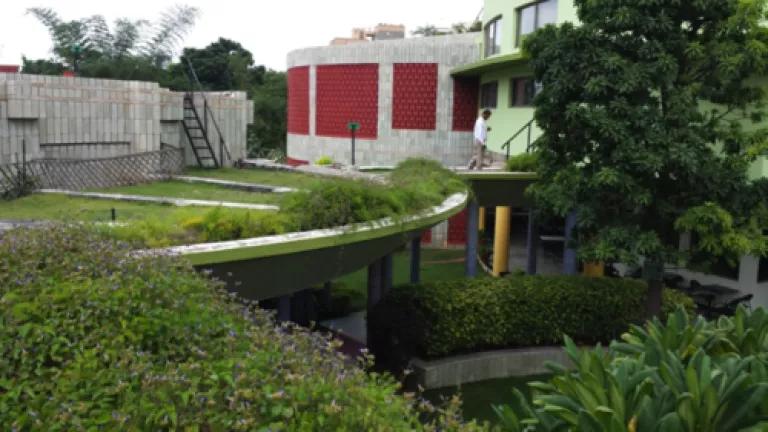
Guest Blog Post by Sarah Klug, NRDC MAP Fellow
“If we can change the way you think about building, maybe what you build will change the world.”
Dr. Prem C. Jain, founder of Spectral Services, made this statement while we were in India earlier this month, summarizing the growing trend toward adopting energy efficiency in buildings throughout India.
While in India, I was excited to see for myself how widespread building energy efficiency has become. India has over 400 LEED-certified buildings, the 6th highest quantity in the world. Energy efficiency in buildings seems to be growing quickly as talk of adopting the Energy Conservation Building Code (ECBC) in states continues. These efforts to ensure buildings are built or retrofitted to use less energy are critical as India continues to grow rapidly. India’s building-occupied area is projected to grow more than 5-fold between 2005 and 2030, making energy efficiency measures necessary to keep up with rising energy demand and reduce future electricity blackouts.
My fellow NRDC colleagues and I recently toured several energy efficient buildings throughout India, including buildings in Noida, Mumbai, and Hyderabad. The tours confirmed for me the generally-accepted principle that implementing energy efficiency measures saves energy and operating costs, and also creates a better environment to work and live. In all of these buildings, the occupants were proud to showcase their efficient building, discuss the efficiency measures taken, and share the savings they were achieving.
Mahindra Towers, Mumbai
In Mumbai, we visited Mahindra Towers, where the team raved about the energy service company (ESCO), ENCON Energy Management Services, who implemented the efficiency measures. The ESCO helped the company through the retrofit process when the company was initially skeptical of the success of implementing energy efficiency. Based on the glowing reviews we heard, the ESCO overwhelmingly convinced Mahindra that energy efficiency does help reduce operating costs and has a short payback period on initial investment. The ESCO conducted an energy audit, invested in energy conservation measures, worked with suppliers to implement the measures, and continually followed up on the success of the measures. Working with the ESCO provided the company with enough confidence in energy efficiency to implement the next round of energy conservation measures internally. They are in the process of identifying appropriate measures now.
Spectral Services Corporate Headquarters, Noida
My colleagues and I also toured the Spectral Services Corporate Headquarters. This building was intriguing because nearly every design feature was determined using energy simulations such as eQUEST. Tradeoffs, such as initial cost and model predicted energy savings, were compared to determine which energy conservation measures to implement and how to design the building. One critical feature is the atrium that spans all levels. This atrium, along with strategically placed windows, provides enough light to keep electrical lights off during the day. Daylight analysis ensured that enough daylight would reach all work areas. I was impressed because buildings in the U.S. are often designed for daylight, but still use electrical lights for most, if not all, of the day.
CII’s Sohrabji Godrej Green Business Center, Hyderabad
CII’s Sohrabji Godrej Green Business Center’s Green Roof. Photo: Sarah Klug, NRDC
The last building we toured was CII’s Sohrabji Godrej Green Business Center, which was the first LEED Platinum building in India. The building was inspired by Former U.S. President Bill Clinton’s speech on building energy efficiency at the Cyber Tower opening. CII worked with the United States’ LEED system to design the building, but ensured that Indian ideals and design concepts were incorporated. For example, an open atrium at the center of the building was included in the design, consistent with traditional architecture of the area. Similar to the Spectral Building, this building is also saturated with natural light, so electrical lights were not used during the day. The roof is composed of plants and grass to reduce heat island effect, rainwater runoff, and heat gain through the roof. This green roof not only helps reduce the energy use of the building, but also provides views and a place for occupants to spend time outside. Inspired by the Green Business Center, CII developed Indian-based frameworks for LEED buildings that are used across the country. The team mentioned that as building energy efficiency becomes more popular and products are becoming more available, the LEED standards are becoming stricter. Innovation and market transformation are driving buildings to go beyond the efficiency of the Green Business Center.
Experiencing these buildings first hand confirmed that energy efficiency can be implemented without having a negative effect on comfort levels or aesthetics. In fact, the occupants we met expressed greater satisfaction with the green features of the building, such as increased natural light and outdoor space. One occupant mentioned that when working in his building, he did not experience the normal tiredness in the middle of the day as he did elsewhere. As India is rapidly constructing buildings, energy efficiency measures should continually be incorporated to decrease projected energy use and increase worker productivity.
The green building tours showcased how each building has its unique challenges and requires a tailored approach, but every building can adopt energy efficient measures. The growing awareness of the benefits of energy efficiency is encouraging and timely as India's building growth continues to expand. More information on energy efficiency building projects will be available in NRDC’s series of case studies, the first of which featured the Godrej Bhavan in Mumbai. Stay tuned for the next case study in this exciting series.
